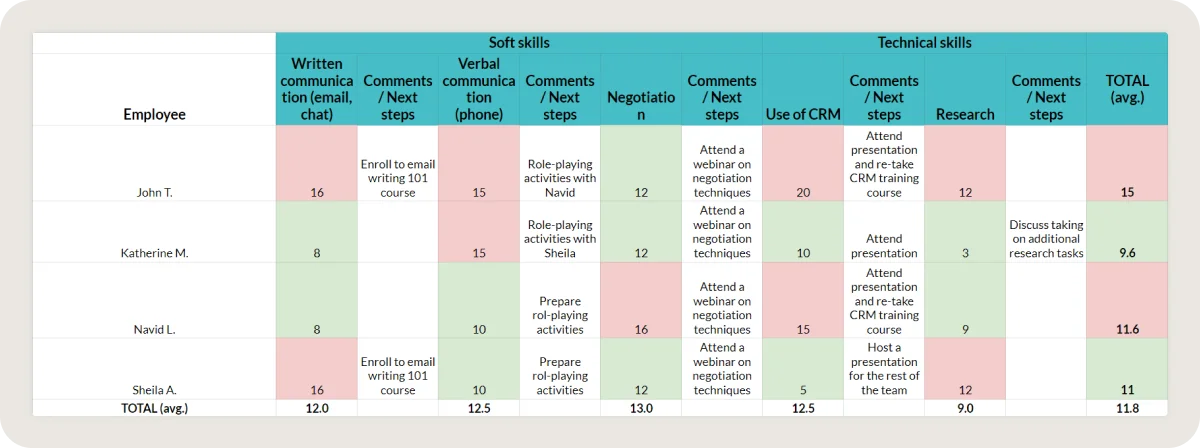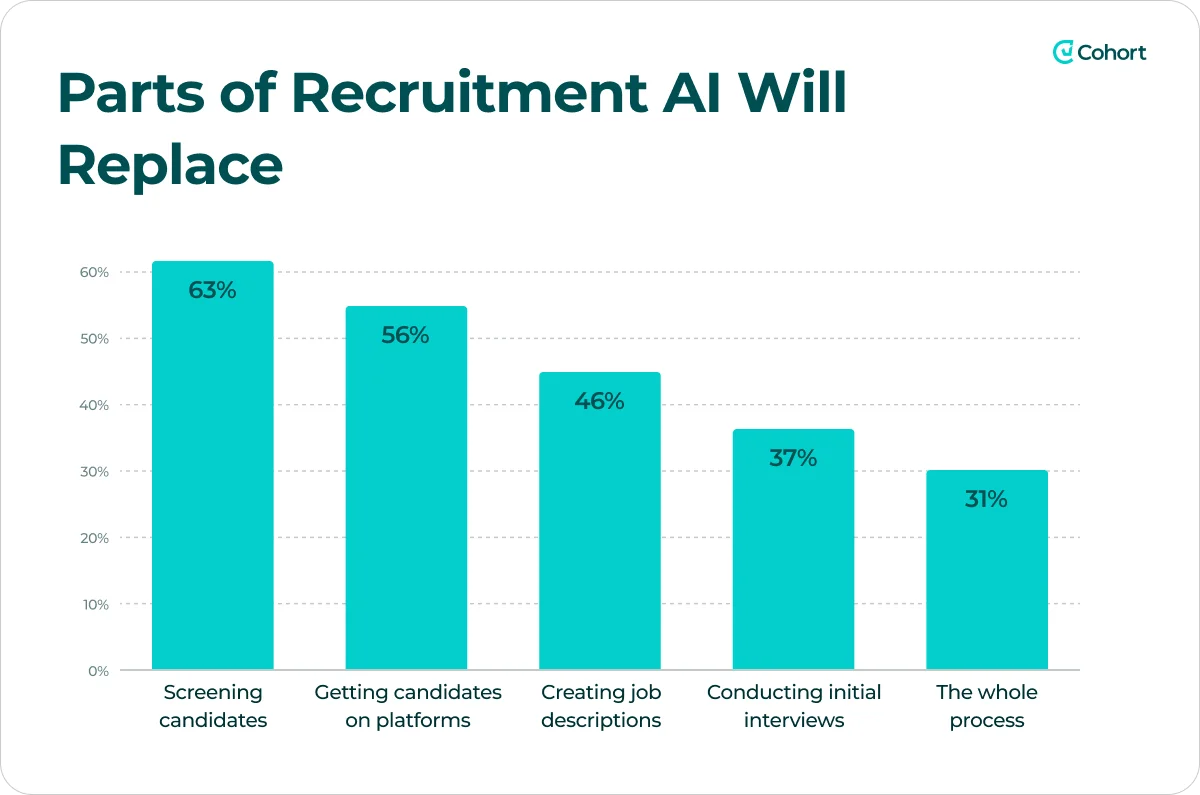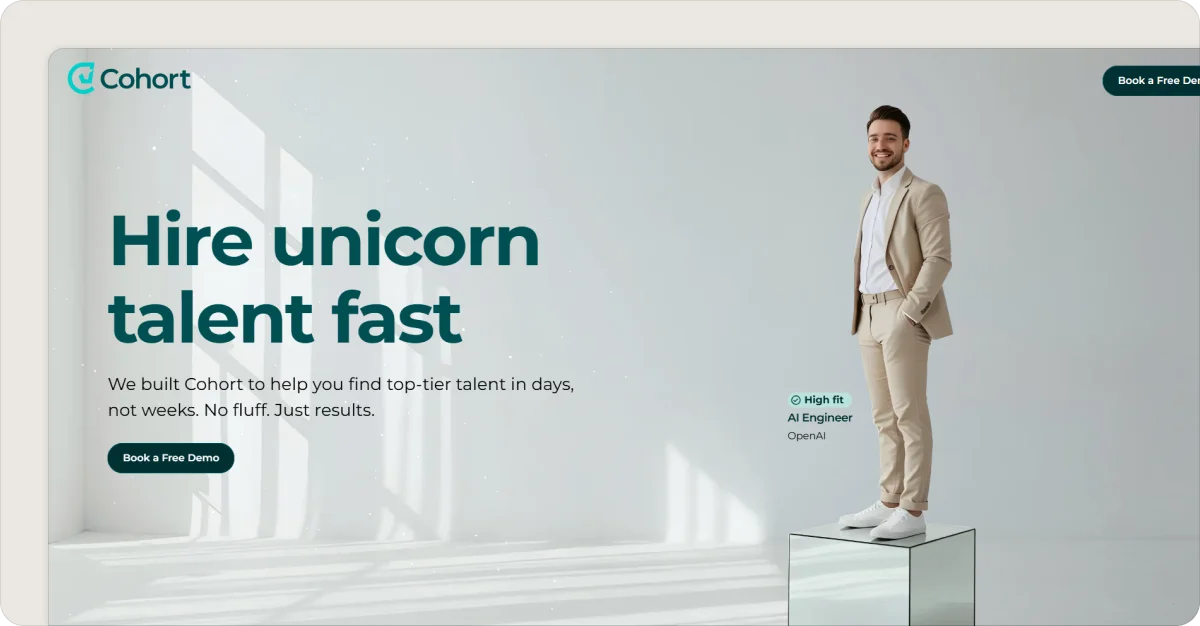Are you struggling to sort through endless resumes, manage interview schedules, and still end up with hires who don’t quite fit?
A bad hire can cost a company as much as $240,000 once you account for lost productivity, training, and turnover.
The good news is that the hiring process doesn’t have to be this costly or complicated.
With the right strategies, HR teams can streamline recruiting, attract stronger talent, and boost retention. In this article, we’ll explore 7 recruiting process best practices to help you build a more efficient and effective hiring system.
Key Takeaways
- Closing skills gaps makes hiring more strategic
A talent gap analysis helps you pinpoint which roles to prioritize, which skills can be built internally, and which ones require external hires. This ensures recruiting efforts stay aligned with long-term business goals while cutting unnecessary costs.
- AI and automation work best with human oversight
AI tools can speed up sourcing, resume screening, and engagement, but they work best when paired with human oversight. Train systems on your company’s success data and keep recruiters involved in key candidate touchpoints to balance efficiency with fairness.
- Candidate experience directly impacts hiring success
From application to rejection, every interaction shapes your brand. Clear communication and respectful treatment boost offer acceptance rates and strengthen your reputation with top talent.
- Diversified sourcing uncovers hidden talent
Relying on just one job board limits reach. A multi-channel approach, including social media, referrals, events, and niche platforms, broadens the pipeline and attracts both active and passive candidates. This approach also strengthens diversity and resilience in hiring.
- Recruit smarter with Cohort AI
Hiring doesn’t have to drain resources. Cohort AI streamlines sourcing, assessments, and engagement in one platform, delivering pre-vetted candidates in days. By combining automation with human insight, you cut time-to-hire by up to 40% while ensuring every new hire is the right fit.
7 Recruiting process best practices to attract top talent
Before we dive deeper into recruiting process best practices, here is a quick overview of what avaits you:
1. Use talent gap analyses to inform recruiting
A talent gap analysis, also known as a skills gap analysis, is a strategic exercise that compares the skills and talent within your organization to what’s needed now and in the future.
In short, this analysis reveals gaps in skills or workforce capacity and helps you target recruiting efforts on the roles that will drive the greatest impact on your company’s success.

✅ How to make it work
- Audit current skills with data, not assumptions: Use performance reviews, project outcomes, and tools like LinkedIn Skills Insights or Degreed to build a skills inventory.
- Map against future needs: Partner with department heads to define the skills tied directly to upcoming initiatives (e.g., AI adoption, market expansion, regulatory compliance).
- Differentiate build vs. buy: Decide which gaps can be closed through upskilling/reskilling and which require external hires. This way, you can save costs and boost retention.
- Translate findings into recruiting assets: Write job postings that highlight mission-critical skills and use them as filters during screening to raise candidate quality.
- Make it continuous: Repeat the analysis annually (or after significant strategy shifts) to ensure recruiting remains aligned with business direction.
🧠 Example: Johnson & Johnson
Johnson & Johnson used AI-driven Skill Inferences to identify gaps and guide workforce planning. Here is what they did:
- Develop a skills taxonomy – They identified the skills most critical to future business plans. Piloting this with the Digital Talent team resulted in 41 skills across 11 core capabilities.
- Collect skills evidence – Employee data from four sources (HRIS, recruiting database, LMS, and project management tools) was gathered to paint a full picture of workforce capabilities.
- Conduct a skills assessment – A machine learning model measured each employee’s proficiency on a scale from 0 (no skill detected) to 5 (thought leadership).
The results:
2. Leverage automation and AI responsibly
AI agents are transforming the recruiting process, making it faster, smarter, and more scalable. From resume screening to candidate sourcing, technology can save recruiters countless hours of manual work.

Recent surveys show that 89% of recruiters using AI say it helps them save time, particularly on administrative tasks. Additionally, companies that have adopted AI recruiting platforms also report 30–50% faster time-to-hire, significant cost savings, and improved quality of hire.
✅ How to make it work
- Train AI with your own success data: Calibrate your tools using performance and retention data from past hires so the system learns what great talent looks like in your organization.
- Use AI to spot hidden patterns: Leverage analytics to identify qualified candidates from nontraditional backgrounds who may be overlooked by keyword-based screening.
- Deploy conversational AI for engagement: Implement chatbots that go beyond scheduling by answering FAQs and delivering personalized role recommendations to candidates.
- Build human-in-the-loop checkpoints: Require recruiters to review AI-generated shortlists and personally handle critical candidate touchpoints to preserve fairness and trust.
- Measure ROI beyond speed: Track performance, retention, and diversity outcomes of AI-assisted hires to prove value to leadership.
💡 Pro tip
When choosing your ATS, avoid juggling multiple tools for outreach, screening, engagement, and shortlisting. The smarter move is to go with an all-in-one platform. You’ll cut costs, reduce complexity, and make hiring far more affordable.
With Cohort AI, you get:
- One place to manage the entire hiring funnel.
- Built-in agents that automate outreach, screening, and engagement.
- Pre-vetted, top candidates delivered in as little as 3 days.
- Less tool-hopping, faster decisions, and fewer drop-offs.

👉 Book a demo today and see how Cohort AI automates your recruiting process!
3. Make candidate experience a priority
Candidates look beyond the job offer and pay close attention to the entire hiring journey. From the first recruiter email to the final offer (or rejection), every interaction shapes how they view your company.
A positive experience can tip the scales for top talent, while a poor one can damage your reputation and cost you both great hires and loyal customers.
Studies show:
- 81% of candidates say a positive experience influenced their decision to accept an offer.
- 49% have declined an offer because of a negative experience.
- 77% of candidates who had a bad hiring experience shared it with others, making it harder to attract talent.
✅ How to make it work
- Set clear communication SLAs: Define internal rules like “respond to every applicant within 48 hours” and “send post-interview feedback within 5 business days.”
- Automate status updates: Use your ATS to trigger automatic emails at key milestones (application received, interview scheduled, decision made) so no one feels left in the dark.
- Audit your application flow: Monitor drop-off rates in your online application to spot where candidates abandon the process. Research shows 60% have quit halfway through because the steps were too long or complex.
- Train interviewers on candidate experience: Provide hiring managers with short training or a checklist on how to run respectful, engaging interviews.
- Close the loop with rejected candidates: Instead of sending generic rejection emails, provide tailored messages or offer brief feedback calls to final-stage candidates. This leaves them with goodwill even if they don’t get the job.
- Measure and improve: Use candidate surveys (e.g., a quick NPS-style rating after each stage) to collect feedback and identify weak points in your process.
🧠 Example: Virgin Media
Virgin Media uncovered a hidden cost of poor candidate experience. When analyzing data, they found:
- 18% of rejected candidates were also paying customers.
- 6% of those canceled their subscriptions after a bad hiring experience.
- Result: $5.4 million in lost revenue per year.
This wake-up call pushed Virgin Media to overhaul its hiring process, putting greater emphasis on clear communication, timely feedback, and respectful treatment of candidates. As a result, they not only recouped lost revenue but also strengthened their employer brand and expanded their talent pipeline.
4. Craft clear and compelling job descriptions
A job description is often the first impression of your company and should go beyond listing tasks and requirements.
Research shows that 83% of Gen Z carefully weigh a company’s mission before applying, making it essential to highlight purpose, values, and culture in your postings.
✅ How to make it work
- Open with a “why”: Instead of starting with duties, lead with one sentence on why the role exists and how it connects to the company’s mission. For example: “This role drives our sustainability goals by developing energy-efficient supply chain practices.”
- Spell out success in year one: Replace vague phrases like “responsible for” with “In the first 12 months, you’ll launch X, improve Y by 20%, and build Z process.” This helps candidates self-assess fit and gets hiring teams aligned.
- Distinguish “must-have” from “learn-on-the-job”: Call out 3–5 non-negotiables, then explicitly note skills that can be developed after hire. This widens your pool without lowering standards.
- Audit for bias with data, not guesswork: Use free tools like Textio, Gender Decoder, or Ongig’s job description scanner to catch gender-coded or exclusionary words that turn away underrepresented groups.
- Show impact and reality side by side: For example, “You’ll lead a small but growing team building our Asia-Pacific presence. The hours can be irregular across time zones, but your work directly shapes global expansion.”

🧠 Example: Walmart’s Skills-Based Shift
Walmart reworked many of its corporate job descriptions to allow applicants to qualify either by having a relevant degree or by demonstrating equivalent skills and experience.
By removing degree requirements for many roles, they broadened their talent pipeline and opened up promotion opportunities to employees who don’t have formal credentials.
Early indicators point to stronger internal mobility and a more inclusive workforce, creating pathways for advancement while also enabling the company to access a wider, more diverse pool of qualified talent.
5. Diversify your sourcing channels to reach more talent
Relying on just one sourcing method (like posting on a single job board) can drastically limit your reach. A multi-channel approach allows you to connect with both active job seekers and those who aren’t looking but may be open to the right opportunity.
✅ How to make it work
- Leverage social media: LinkedIn remains the top source for professional networking, but don’t stop there. Share openings on Twitter (for tech and media talent), Instagram and TikTok (great for employer branding and attracting younger candidates).
- Tap into referrals: Employee referrals consistently produce high-quality hires, with referred candidates being hired 55% faster and staying 25% longer than those hired through other channels.
Create an incentive program (such as bonuses, recognition, or perks) to encourage staff to recommend individuals from their professional or personal networks.
- Engage in events: Join or host conferences, meetups, hackathons, and university fairs. These settings expand your reach and give candidates a genuine sense of your company culture, with many tech firms successfully hiring candidates at hackathons through sponsored challenges.
- Explore niche platforms: Use industry-specific job boards, professional associations, or forums when hiring for specialized roles.
🧠 Why is this important:
About 37% of U.S. workers are passive candidates who are not actively job-hunting but open to new opportunities. They may never see your job board listing, but they might:
- Come across a thought-leadership piece from your CEO on LinkedIn or another platform.
- Hear about your company on a podcast, webinar, or industry panel.
- Get a tailored outreach message from a recruiter or employee in their network.
💡 Pro tip
Constantly looking for talent across different platforms can consume a lot of time and drain valuable recruiting resources. With Cohort AI’s Sally the Sourcer, you are always on talent scout, finding high-signal profiles before they ever reach job boards. She crawls GitHub, LinkedIn, Stack Overflow, and Kaggle to identify and score top technical talent, saving you 20–30 hours of manual sourcing each week.
6. Focus on your priority recruitment metrics
“You can’t improve what you don’t measure” applies perfectly to recruiting.
The most successful HR teams today are highly data-driven. They rely on carefully chosen KPIs to monitor performance, identify bottlenecks, and continuously improve results.
Some common recruiting metrics include:
- Time-to-fill – number of days to close a vacancy
- Time-to-hire – speed from application to accepted offer
- Cost-per-hire – how much you spend to make a hire
- Quality of hire – long-term success and performance of new hires
- Candidate drop-off rates – how often candidates leave mid-process
- Offer acceptance rate – how often offers are accepted
- New-hire retention – how long new employees stay

✅ How to make it work
- Pick the right metrics for your goals: If you’re scaling quickly, emphasize speed metrics (time-to-fill, time-to-hire). If retention and performance are more important, prioritize quality and retention.
- Avoid vanity metrics: Don’t track data that looks good but doesn’t inform better decisions.
- Prioritize quality of hire: Research shows it’s the #1 hiring metric in 2025, as it directly links to productivity, innovation, and business success. Measure it with retention rates, performance reviews, and hiring manager satisfaction.
- Balance efficiency with effectiveness: Speed matters, but a fast, bad hire is still a bad hire. Combine time-based metrics with quality-focused ones.
- Benchmark against industry standards: For example, if your cost-per-hire is far above the U.S. average of ~$4,700, it’s a sign of inefficiency. If your time-to-fill is 45 days while candidates expect an offer within 2 weeks, your process needs attention.
7. Build a strong employer brand to attract top talent
Just like consumers choose trusted brands for products, job seekers are drawn to companies with a strong employer brand.
A positive employer brand acts like a magnet, drawing in more applicants (and often better-qualified ones), while a poor reputation can stop candidates from applying at all.
Studies show that:
- Companies with a strong employer brand can cut cost-per-hire by up to 50%.
- Three out of four candidates research a company’s reputation before deciding to apply.
- 86% of job seekers look at reviews and ratings to evaluate potential employers.
- 92% of professionals would switch jobs to a company with an excellent reputation, even if the pay stayed the same.
✅ How to make it work
- Define your Employee Value Proposition (EVP): Clearly outline what makes your company unique (e.g., culture, growth opportunities, work-life balance).
- Showcase employee experiences: Use your careers page, social media, and awards (like “Best Places to Work”) to highlight authentic stories.
- Empower employees as ambassadors: Encourage staff to share their experiences on LinkedIn, Glassdoor, and other platforms, as candidates trust employee voices 3x more than executive messaging.
- Elevate the candidate experience: Streamline applications, give timely feedback, and treat every applicant with respect, as positive interactions strengthen your employer brand, even with rejected candidates.
Recruit smarter with Cohort AI

Cohort AI integrates generative AI into everyday HR workflows, spanning sourcing, assessment, engagement, and beyond, so teams can hire faster, communicate more effectively, and scale without increasing headcount.
In just a few days, it identifies the top three candidates for any technical role, while Talent Architects fine-tune the search to ensure every candidate is the right fit, cutting time-to-hire by 40%.
How Cohort AI helps you:
🟢 Smarter talent sourcing – Find high-potential candidates by highlighting real skills and achievements, not just what’s on a résumé.
🟢 Simplified assessments – Run role-specific, on-demand interviews and score them against clear success criteria for fair, consistent hiring.
🟢 Personalized outreach – Send tailored messages that reflect your brand and the role, helping you attract and engage top talent.
🟢 Stronger candidate engagement – Keep communication flowing with automated follow-ups and quick answers to candidate questions, reducing drop-off.
🟢 Intelligent matching – Match candidates to roles by analyzing skills, behaviors, and working styles, focusing on how they work, not just where they’ve worked.
With Cohort AI, you get your top three candidates in just days, carefully vetted by AI and refined by human expertise.
Book a demo today and see how Cohort AI helps you apply recruiting best practices while cutting time-to-hire in half!













